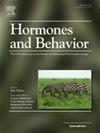长期暴露于青春期前后的leuprolide会影响雌性和雄性Long-Evans大鼠下丘脑和垂体中多种基因的表达,且表达模式不同
IF 2.4
3区 医学
Q2 BEHAVIORAL SCIENCES
引用次数: 0
摘要
长期暴露于像Lupron Depot®这样的药物会抑制青春期发育。面对药物抑制,大脑如何反应和发育尚不清楚。本研究采用实时荧光定量PCR技术检测了每天给药(50 μg/kg,产后(PD) 25-50天)醋酸LEU (LEU)对雌性和雄性Long-Evans大鼠下丘脑和垂体基因(Kiss1、Esr1、Esr2、Ar、Gnrh1、Gnrhr)表达的影响。PD 50采集了大脑和躯干血液。在两性垂体中,leu处理大鼠的Esr2和Gnrhr表达高于生理盐水对照组。与生理盐水对照组相比,leu处理的大鼠中雌性的Esr1表达较低,雄性的Ar表达较高。在雄性大鼠下丘脑视前区,Kiss1在LEU中的表达明显低于生理盐水对照组。在下丘脑中基底区,低leu处理的雄性大鼠Gnrh1和Kiss1的表达高于生理盐水对照组;在治疗结束时,低LEU处理的大鼠血清性腺激素水平与生理盐水对照组相比没有显著差异,尽管低LEU处理的大鼠血清性腺激素水平呈下降趋势。低LEU影响生殖相关基因的表达,这可能解释了之前报道的低LEU对行为的性别特异性影响。下丘脑和垂体基因表达的变化可能代表了在LEU治疗期间允许早期青春期发育(例如,VO和PPS),但不完全成熟(例如,发情周期,性行为)的补偿。本文章由计算机程序翻译,如有差异,请以英文原文为准。
Chronic periadolescent leuprolide exposure affects the expression of multiple genes in the hypothalamus and pituitary gland with a different pattern of expression in female and male Long-Evans rats
Protracted exposure to drugs like Lupron Depot® suppresses pubertal development. How the brain responds and develops in the face of pharmacological suppression is not well understood. The present study tested the effects of daily leuprolide acetate (LEU) treatment (50 μg/kg, postnatal day (PD) 25–50) on gene expression (Kiss1, Esr1, Esr2, Ar, Gnrh1, Gnrhr) in the hypothalamus and pituitary of female and male Long-Evans rats using real-time PCR. Brains and trunk blood were harvested on PD 50. In the pituitary gland of both sexes, expression of Esr2 and Gnrhr expression was higher in LEU-treated rats than in saline controls. Esr1 expression in females was lower and Ar expression in males was higher in LEU-treated rats than saline controls. In the preoptic area of the hypothalamus in male rats, Kiss1 expression was significantly lower in LEU than in saline controls. In the mediobasal hypothalamus, Gnrh1 and Kiss1 expression was higher in LEU-treated male rats than in saline controls; for females, only Kiss1 was increased by LEU. Serum gonadal hormone levels were not significantly different in LEU-treated rats than saline controls at the end of treatment, although hormones trended lower in the LEU-treated rats. LEU affected expression of genes involved in reproduction, potentially explaining sex-specific effects of LEU on behavior reported earlier. The changes in hypothalamic and pituitary gene expression may represent compensation that permits early stages of pubertal development (e.g., VO and PPS), but not complete maturation (e.g., estrous cyclicity, sexual behavior) during LEU treatment.
求助全文
通过发布文献求助,成功后即可免费获取论文全文。
去求助
来源期刊

Hormones and Behavior
医学-行为科学
CiteScore
6.70
自引率
8.60%
发文量
139
审稿时长
91 days
期刊介绍:
Hormones and Behavior publishes original research articles, reviews and special issues concerning hormone-brain-behavior relationships, broadly defined. The journal''s scope ranges from laboratory and field studies concerning neuroendocrine as well as endocrine mechanisms controlling the development or adult expression of behavior to studies concerning the environmental control and evolutionary significance of hormone-behavior relationships. The journal welcomes studies conducted on species ranging from invertebrates to mammals, including humans.
 求助内容:
求助内容: 应助结果提醒方式:
应助结果提醒方式:


